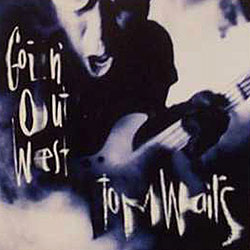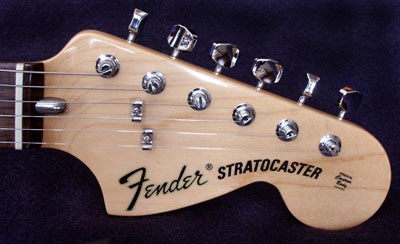Want To Start An Instant Argument? Let’s Talk About ’70s Fenders!
Published on December 5th, 2011 in: Dancing Ourselves Into The Tomb, Issues, Music, Over the Gadfly's Nest |
Another fellow that knows a thing or two about tone is Joe Gore, guitarist, journalist, and all-around smartypants when it comes to good musical taste. Mr. Gore was senior editor of Guitar Player magazine in the ’90s, works as a music software development consultant for Apple, and has toured and recorded with an almost freakishly diverse assortment of artists including PJ Harvey and eels. Joe recently revealed to me that his tremoloed guitar tone on Tom Waits’ “Goin Out West,” one of the most bad-assed, evocative guitar sounds of all time, was generated by a silverface Super Reverb. Granted, evocative bad-assery is Joe’s stock in trade, but the amp? Nothing particularly special or unusual. Just a good ol’, garden variety post-CBS mid-sized Fender.
Mr. Gore recently related the following on his experience with ‘70s Fender amps:
“I’m no mega-expert on ’70s Fenders, but I have owned two that represent the breed at their best and worst. The first was an awful mid-decade Twin Reverb I owned when I was a kid. It was one of those monsters with JBL speakers. It weighted a ton, was sadistically loud, and had no personality whatsoever. I got rid of it as soon as I learned enough to know better.
“The other one is a happier story: In the late ’80s I used to play through a pair of Super Reverbs, one blackface and one silverface. Again, I eventually learned better and realized there’s no real reason to have that much power on a club stage, and I sold the blackface. (This was when blackface Supers fetched about $400.) The early-’70s Super just sounded better! I used it on my first sessions with Tom Waits—including Bone Machine—and on many other projects. I got deeply into EL84 amps for years, and the Fender lay dormant. But I pulled it out for the last Tracy Chapman tour I did the year before last, and it sounded perfect with no maintenance whatsoever. The band for that tour had no bassist, just Tracy’s standard tuned guitar, my baritone (tuned to AEADF#B, low to high), and drums. The Super worked incredibly well for the low-register stuff—I don’t think anyone ever missed the no-bass instrumentation.
“I guess the lesson is, there are some good ones and some bad ones. The CBS takeover happened suddenly, but everything in Fullerton did not turn to crap overnight. Sadly, that’s not much of a secret, and the price for ’70s Fender gear has of course risen astronomically. But if you find something from the era that sounds good, it probably is good.”
Even in the Seventies, when everyone wanted walls of Marshalls, a small Fender combo amp could rock—even one that was new at the time! Witness the footage of T. Rex’s Marc Bolan in rehearsal in the sublimely goofy Born To Boogie: When Bolan’s not onstage wearing a shirt with an oversized print of his own face on it while standing next to an oversized cardboard cutout of himself rocking out, he’s banging not a gong, but a white Stratocaster through what appears to be a sparkly new silverface Princeton while the band practices. And it sounds pretty awesome!
To be fair, the Seventies weren’t that kind to all of Fender’s amp line. In an effort to tame “undesirable” distortion and produce a louder, cleaner-sounding amplifier, by early in the decade, Fender was doing some pretty questionable stuff to their amps, particularly larger models like the Twin Reverb. In fact, of all the amps I’ve encountered, I don’t think I’ve seen more variation in one model of amp than the ’70s Twin. “Ultralinear” transformers introduced in the early Seventies produced a louder, cleaner Twin, but often at the expense of many of the traits that made earlier amps desirable, and by the late Seventies, many Fender amps had in fact departed significantly from Leo Fender’s original designs. Some examples are better than others, though, and in many cases, modifying the circuits back to original specification is possible.
Interestingly enough, despite attempting to make their amps louder and cleaner, by the end of the decade, most Fender amps featured a master volume control, which in theory allows for more distortion from the input gain stages of the circuit. As noted above, Marshall amps had long since come into fashion, Mesa/Boogie was beginning to make a name for themselves, and Fender had to attempt to keep up. I believe this is where much of the bias against Seventies Fender amps comes from, and in my humble opinion and experience, these tend not to range from “meh, not bad but I’d mod it back to blackface spec” to “it’s frankly just all-around unpleasant and uninspiring to use.”
Much of Fender’s new for the time offerings fall into this category, like the way too-loud, 180-watt Super Twin, or the Quad Reverb and Super Six Reverb, basically Twins with four 12″ or six 10″ speakers. They weren’t all bad, though again, the smaller end of the spectrum is where an unlikely winner is to be found. At around 10 watts with one 12″ speaker, the Musicmaster Bass amp, offered as small student or practice amp, isn’t much to write home about—for bass. Used as a guitar amp, though, they’re pretty great, offering a bit more muscle than a Champ, but at a lower volume level than a Princeton or Deluxe.

Fender Classic 70s Stratocaster ‘Big’ CBS Era Headstock
Photo © Invisible1955
Fender’s guitars of the era seem to have fared similarly. At the dawn of the Seventies, some cosmetic changes had been in place for several years—headstocks on most models were of the larger, post-CBS variety, with many models featuring a “bullet” truss rod adjustment at the headstock. While functionally an improvement—one could now adjust the curvature of the neck without removing it from the body—depending on one’s taste, it can be viewed as an unsightly hunk of metal.
Jaguars, Jazzmasters, and Jazz Basses featured bound necks with block inlays, and with some exceptions, the numbers of models offered in the lovely and popular DuPont “custom colors” declined in favor of more opaque blonds, Olympic Whites, and sunbursts, eventually giving way to the popularity of natural finishes. By the end of the decade, Fender offered a walnut brown finish so unappealing that a vintage guitar price guide used at the shop I worked in laughably instructed to increase the value of a Strat by 20% for custom colors—except that one, in which case one should deduct 10%.
Time limit is exhausted. Please reload the CAPTCHA.